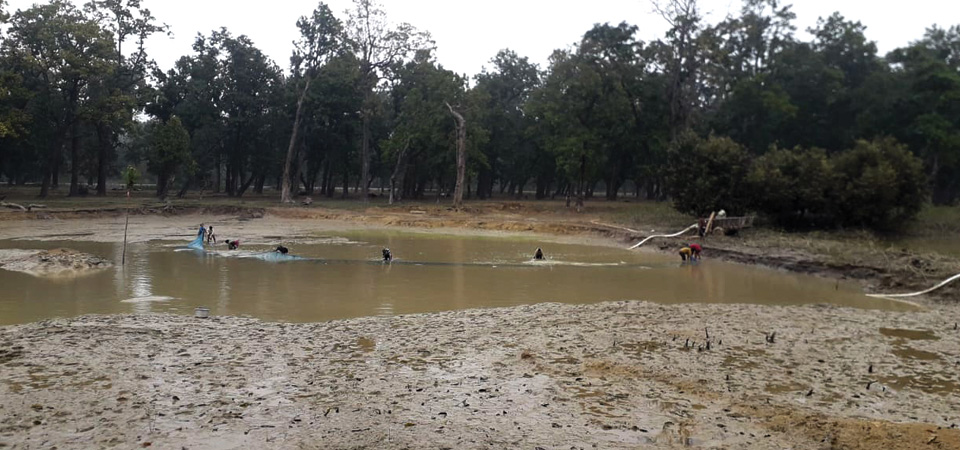Kailali's wetlands disappearing

By Abinash Chaudhary
Dhangadi, Feb. 3: The wetland area, considered the earth’s kidney, is being eroded in Kailali due to a lack of protection and conservation efforts.
Stakeholders are of the view that wetland areas are being destroyed day by day due to unmanaged use of water for income generation.
Conservationist Puskal Bam, who is also the chairperson of the Basanta Protected Forest Council, said that the main reason for the erosion of the wetland area is the indiscriminate exploitation of the lakes and rivers. “The sad reality is that it has become hard to distinguish a wetland from a fishpond?” he said. Earlier lakes of many places have become land these days.
A wetland area is a swampy area where water does not dry out round the year. It is believed that 40 per cent of the earth's creatures, including aquatic animals, birds and wildlife, are directly dependent on the wetland for survival.
Similarly, the wetland area plays an important role in storing water and recharging it underground. It is called the nature’s kidney because it accumulates waste in the water. It is both a breeding ground and playground for many wildlife. For water birds, their whole world is a wetland.
However, they are being destroyed day by day due to encroachment and haphazard construction of infrastructure, said conservationist Hirulal Dangaura.
“The world of waterfowl is being devastated by the destruction of wetlands,” Dangaura said, who is working as an ornithologist at the Nepal Bird Conservation Association (BCN). “Lately, the number of waterfowl in the wetland seems to be declining,” he added.
According to the statistics of the then District Development Committee, there are 182 lakes in Kailali, known as the district of Talatlaiya. It is estimated that the number of lakes has increased recently as artificial ponds have been constructed in various community forests. However, some natural lakes have dried up and many are in process of drying up.
According to Dangaura, fish farming in the lake in an unorganised manner and drying up the lake is against the essence of wetland. He said that the number of waterbirds in the protected Basanta forest area – such as Loukabhauka, Jamnehata, Chamrahiya, Ghodtal and Sonia Rupiya – is in decline due to fishing and drying up the lake. “Because of the hunting of birds, many birds have stopped inhabiting Laukabhauka Lake,” he said.
The Ghodaghodi Lake area and Rakhona wetland, which are listed in the World Ramsar area and which are in the protected Basanta, are also in crisis. Dumping of plastic waste has increased in the Ghodaghodi wetland area, while fish farming and drying up of water are being done in Rakhona. Wetlands can be used for income, but for that, it is also necessary to protect the environment. “If not, there will be no wetlands for the future generation,” he said.
Mentioning that many lakes had been dried up recently, Gokul Rijal, Forest Officer of Division Forest Office, Pahalmanpur, said that much work remained to be done for the improvement of wetland.
“The local government and the concerned office must come up with a plan,” Rijal said, adding that the forest body is sensitive to wetland conservation and has been working for the promotion of the aquatic ecosystem.
Recent News

Do not make expressions casting dout on election: EC
14 Apr, 2022
CM Bhatta says may New Year 2079 BS inspire positive thinking
14 Apr, 2022
Three new cases, 44 recoveries in 24 hours
14 Apr, 2022
689 climbers of 84 teams so far acquire permits for climbing various peaks this spring season
14 Apr, 2022
How the rising cost of living crisis is impacting Nepal
14 Apr, 2022
US military confirms an interstellar meteor collided with Earth
14 Apr, 2022
Valneva Covid vaccine approved for use in UK
14 Apr, 2022
Chair Prachanda highlights need of unity among Maoist, Communist forces
14 Apr, 2022
Ranbir Kapoor and Alia Bhatt: Bollywood toasts star couple on wedding
14 Apr, 2022
President Bhandari confers decorations (Photo Feature)
14 Apr, 2022











